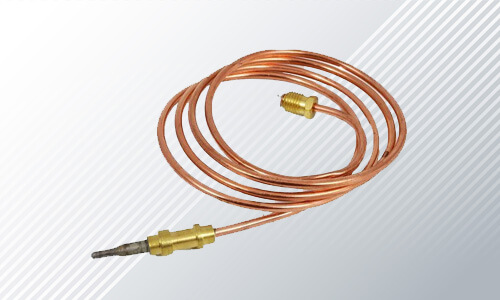What is a Temperature Sensor? (Contact, Non Contact, Semiconductor Types)
A temperature sensor is an electronic device used to detect and measure the temperature of its environment or any content required to be measured, whether that is solids, liquids, or gasses, and converts the input data into an electrical signal. There are many cases in your daily life and in different branches of industries where a temperature sensor is used.
There are different technologies and principles to measure the temperature in various specific applications because different applications make one technique more useful than the others for each specific case and there’s no unique way suggested for all applications.
What is the difference between the temperature transmitter and temperature sensor?
The temperature transmitter is an electrical instrument, which connects to the temperature sensor and interfaces with it to transfer a signal from the sensor to a remote location for monitoring and controlling purposes. It is a device to help measure and warn of temperature changes.
So, this means a thermocouple, RTD, or thermistor is connected to a data logger to gain the data at any remote location.

Different Types of Temperature Sensor
There are many different types, shapes, and sizes of Temperature Sensors available, and all have different characteristics depending upon their application. The two main physical types of temperature sensors are Contact and Non-contact temperature sensors.
Contact Type Temperature Sensors
These types of temperature sensors need to touch the physical object that they’re detecting and, measure its temperature and utilize conduction to monitor changes in temperature.
They can be used to identify solids, liquids, or gasses over a wide range of temperatures.
These sensors actually just measure their own temperature, but we infer that the temperature of whatever it’s in contact with it is in thermal equilibrium (i.e. are the same temperature).

Non-contact Temperature Sensor Types
These types of temperature sensors are not in direct contact with the object and measure temperatures remotely by use of radiation and convection emitted by an object or heat source to monitor temperature changes.
They are suitable for the detection of gasses and liquids that release radiant energy as heat rises in convection streams.
They are applicable for use in high temperatures or hazardous environments where there is a need to keep a safe distance away from a particular body.
The two principal types of contact and non-contact temperature sensors are further divided into the following groups of sensors, Electro-mechanical, Resistive, and Electronic.

Semiconductor Temperature Sensors
Semiconductor temperature sensors are instruments that are provided in the form of ICs and for this reason, are also known as IC temperature sensors.
Current output temperature sensor, Voltage output temperature sensor, resistance output silicon temperature sensor, diode temperature sensor, and Digital output temperature sensor are different types of these sensors.
Today, semiconductor temperature sensors provide high linearity and high accuracy over an operating range of about 55°C21 to +150°C. AD590 and LM35 are two types of semiconductor temperature sensors that are the most popular.

What is a Temperature Sensor Used for?
Temperature sensors as a crucial tool are all around us; exist in both everyday life and more industrial settings such as food processing, medical applications, petrochemical handling, automotive monitoring, biological research, geological studies, HVAC systems, and other consumer electronics.
Actually, they’re also used throughout our own houses and offices, within the transport we travel in, and even in instruments we use every day!
For example, when you leave your smartphone in your car on a hot day, your screen shows an image of a thermometer and a warning that your phone has overheated.
That is because of a tiny embedded temperature sensor that measures the interior temperature of your phone. Once the inside of the phone reaches a specific temperature, the temperature sensor sends an electronic signal to an embedded computer.
This, in turn, limits you from accessing any applications or features until the phone has cooled back down because running programs would only further damage the phone’s interior components.
Some application areas for temperature sensors are;
- Monitoring and controlling varied machinery and environments, power plants, and production.
- Scientific and laboratory applications, Science, and biotech controlling.
- Medical Applications, Patient monitoring, medical tools, gas analysis, thermo dilution cardiac catheters, humidifiers, ventilator flow tubes, dialysis fluid temperature.
- Motorsport, Exhaust gas, inlet air temperature, oil temperature, and measuring engine temperature.
- Domestic appliances, Kitchen appliances (ovens, kettles, etc.), and white products.
- HVAC applications, Heating ventilation, and air-con instruments either industrial or domesticated.
- Transit, Refrigerated vans, and lorries.
To learn more about please refer to Temperature Sensor articles:
How to Choose a Temperature Sensor?
Everything About Temperature (Units and Unit Conversion)
Common Applications of Temperature Sensors
Types of Temperature Sensors (RTD, Thermocouple, Thermistor, Semiconductor, Thermometer)
Recent Posts
-
Mastering Water Pump Care in Dubai: Installation, Maintenance, Repair, and Efficiency Tips
I. IntroductionWhy Water Pumps Matter for Dubai HomesIn Dubai’s arid environment, water pumps are es …21st Nov 2024 -
How to Choose and Purchase the Right Water Pump in 2025: A Complete Guide for Dubai Homes
1. IntroductionIn 2025, water pumps have become an integral part of many homes in Dubai, ensuring a …14th Nov 2024 -
Damping the Chaos: The Role of a Pressure Snubber
Imagine this: A critical process is underway. A team of engineers has meticulously planned and …5th Nov 2024




